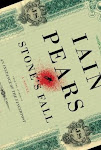
Happy Monday, everyone! Today I have a special Guest Post from Emily Listfield, author of Best Intentions
I am especially pleased by this guest post. I have some friends who are writers and I am always interested in the way that writers approach their craft. That's one of the reasons I love going to book signings - I love to hear authors talk about their work. Emily Listfield was kind of enough to tell me a little about her creative process for Best Intentions, and I am really happy to be sharing that with you:
When I started writing Best Intentions I pinned an index card above my desk with four words written on it: Social Observation, Suspense, Fast, Fun. I had just finished writing a pretty intense novel, Waiting to Surface, based on my husband’s disappearance and death - and I knew that I wanted to do something totally different. Those four words served as a reminder of the tone and feel I was aiming for this time. A few months after I started writing Best Intentions, I was having drinks with my (then) boyfriend. I was attempting to put into words what the novel was about: How it’s easy to assume you know what someone you love is thinking, but without real communication you may be totally wrong – with deadly results. He asked if I knew this quote: The worst, most corrupting lies are problems poorly stated. I hadn’t heard it before, but that one line helped to crystallize my theme. I had him write it down immediately so I wouldn’t forget it. When I got home, I pinned it up next to the index card. That quote became the epigraph for the book. (He couldn’t remember where it was from. I found out that it was by George Bernanos by Googling it.) Anyway, those two scraps of paper where the first thing I saw when I went to my desk every morning to write –bookends about tone and theme.
I’m a morning writer. I get too distracted (and burned out) later on, especially when I’m writing a first draft. (I find re-writing easier and can go longer stretches of time.) If I’m working at home, I often like to write for at least a little while before I’ve even showered (after I’ve gotten my daughter off to school.) My head is less filled with ephemera, emails, etc. If I’m feeling stuck, I take a legal pad and pen and sit in another room, or a coffee shop. It’s somehow more immediate and can help break the logjam. Many days, I go to a place called the Writers Room in NYC – a kind of co-op that’s open 24/7. Because you can’t use phones or talk in the main room, a few hours there is like dog years. You get a lot done when you’re not wandering to the kitchen, checking out the news, fiddling around.
It took about a year and half to write Best Intentions. The day I finished, I took the two notes down from my bulletin board. They had done their job.
I want to thank Emily for stopping by my blog! For more information on her work, check out EmilyListfield.com or read Emily's blog, Brunch Babble.






5 comments:
Great post! Those two notes are a great visual.
Thanks so much for this! I'm more of a morning writer too, so I like hearing how people manage their time.
I love the "bookend" quotes, about tone and theme. Whatever it takes to keep your concentration and focus.
Thanks for the insight!
Thanks for giving us a peek into the process!
I need a place to write away from my meowing cat!
Great post! What a great time to be catching up in blogs where I'm behind!
Post a Comment